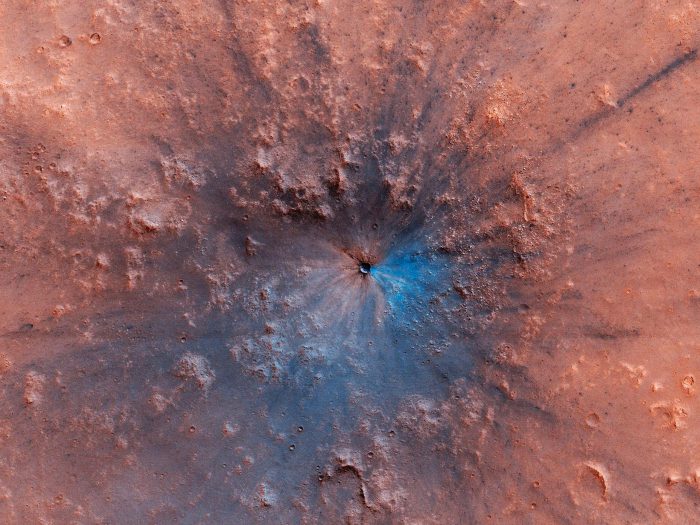One of the things that really makes Earth stand out from the four terrestrial, or rocky, planets is its wildly changing surface. While Mercury's surface looks as samey-grey as the Moon's, Earth is a wild mix of blue oceans, white ice, verdant greens, and warm browns.
Mars? Though it's got more going on than Mercury, it isn't called the Red Planet for nothing. The planet is covered almost tip to tail in a husky reddish-brown colour. But if you look hard enough, there are little differences that are quite beautiful.
The latest example? A new crater discovered on Mars' surface has revealed something blue under all that red!
Let's just brush that dust aside...
The Mars Reconnaissance Orbiter in July 2005, just weeks before it was launched. (Getty Embed)
The crater at the top of this post was photographed on April 17, 2019 by HiRISE, a special high resolution camera on board the Mars Reconnaissance Orbiter (MRO) currently above the planet. It is estimated that the asteroid that hit it was only around 1.5 metres (5 feet). Though space rocks this size are easily burned up in our thick atmosphere, on Mars, they smack the surface.
The force of this impact literally blew the red dust on the surface away. So what looks like a charred surface around the crater — as though it was blackened by an explosion — is actually just the colour of the surface underneath the dust. And yes, that includes the bluish material that is seen to the right of the crater.
Black and blue
An example of basalt on Earth's surface. (Getty Embed)
The blackish rock is probably basalt, a kind of dark igneous (volcanic) rock. And this blue stuff? What's it's story you ask?
Scientists estimate that it is could be ice. That would figure on some level — Mars is, after all, quite cold. But it makes you wonder, just how much of it is there under just a few feet of red sand? Is Earth the only Blue Planet in our inner solar system, or are we getting closer and closer to understanding the watery truth of Mars?
We suppose that all we need is a few thousands more asteroids to hit Mars in the next while to know...
 Whatever slammed into the Martian surface, it sent dust flying, exposing darker rock and something blue... (NASA/University of Arizona)
Whatever slammed into the Martian surface, it sent dust flying, exposing darker rock and something blue... (NASA/University of Arizona)










so cool
Really cool!
Next thing we know
we’re building a house on the red planet.
LOL
😛
that is the coolest thing iv’e ever seen in my intire life! thats so amazing. im looking forward to see what it turns out to be. thanks for sharing with every body.
❗ 💡 I think I know what this it!! 😎 Mars is red bc its rusty, and I think 1 meteor impacted mars so hard it blew a ton of the rusty dust off and revealed a non-rusty surface below
Looks like mars got hit by a bunker buster,that blue color seemingly the real color of mars,that’s covered by dust,thick soft crust